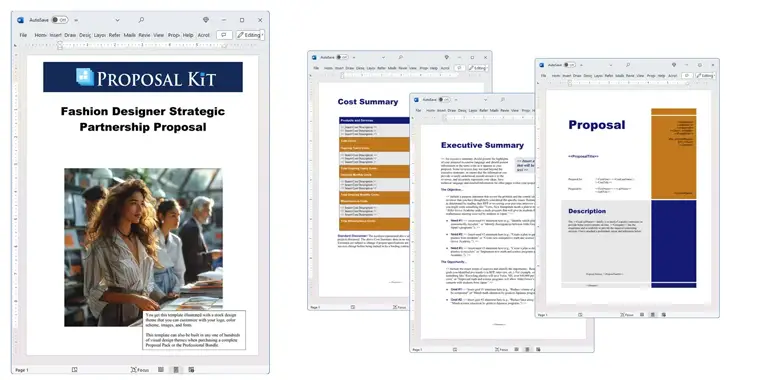How to write your Fashion Designer Strategic Partnership Proposal
We include this 27 page layout with every Proposal Pack. If you want this template to have a different visual design theme than the one illustrated here, purchase any Proposal Pack design and create this template using the purchased design theme. This template is included in every Proposal Pack. If you get a Proposal Pack or the Professional, you can also make any variation of this template with different chapters to suit your needs.
We typically include more chapters in the templates than most people will need to give everyone more variety in the chapters they may need. You can trim down a long template by removing pages you do not need or combining multiple chapter topics into one page.
 DOWNLOADABLE, ONE-TIME COST, NO SUBSCRIPTION FEES
DOWNLOADABLE, ONE-TIME COST, NO SUBSCRIPTION FEESYou can also create countless variations of this document to suit your needs using the included library of 2200+ chapters if ordering a Proposal Pack or Professional.
 What Our Clients Say
What Our Clients SayI am really glad that I bought the Proposal Pack from your site. I actually bought it to use as a general reference tool because I didn’t really think that it was going to be as comprehensive as it actually is. The reaction from my existing clients has been great."
ACTIS
Related Article
Related Video
Related Templates
- Fashion Industry Proposal
- Fashion Designer Product Sales Proposal
- Fashion Runway Show Competition Proposal
- Joint Venture Proposal
- Collaboration Proposal Template
- Business Partnership Proposal Template
- Brand Collaboration Proposal Template
- Artist Gallery Consignment Sales Proposal
- Resource Sharing Proposal
- Garment Tailoring and Wardrobe Project Proposal
- FinTech Strategic Partnership Proposal Template
- Luxury Spa and Hotel Joint Venture Proposal
- Artist Custom Design Services Proposal
What's the Best Way to Write Your Fashion Designer Strategic Partnership Proposal?
A proven approach is to write your fashion designer partnership proposal using the Proposal Kit template and software package. Proposal Kit offers a comprehensive solution, simplifying the process of creating professional, detailed, and persuasive proposals that can help secure valuable partnerships. It includes a line-item quoting system for costs, budgets, and other financial pages.
Understanding the Fashion Designer Strategic Partnership Proposal
Writing a fashion designer partnership proposal involves showcasing your fashion brand's unique strengths and articulating how a partnership would be mutually beneficial. With Proposal Kit, you can easily navigate this task using its structured templates and intuitive software.
Are you facing the challenge of writing such a proposal? If so, read on to learn how Proposal Kit can make this process easier and more effective for you.
What Types of Projects Are Fashion Designer Strategic Partnership Proposals Written For?
Fashion designer partnerships can encompass a variety of projects. Here are ten examples:
- Launching a co-branded fashion line
- Collaborating on exclusive fashion events or runway shows
- Partnering with influencers for marketing campaigns
- Developing a new collection with another fashion brand
- Expanding into new retail markets or regions
- Joint ventures for sustainable fashion initiatives
- Creating limited-edition pieces for special occasions
- Cross-promotional partnerships with complementary brands
- Licensing agreements for fashion designs
- Partnering with technology firms for smart fashion innovations
Chapters this template is built with
There is no one-size-fits-all template for all fashion proposals. Proposal Kit provides a starting point with chapters that can be customized using its extensive library of thousands of templates.
This list of chapter templates represents a small selection of the thousands of templates available in Proposal Kit's template library. You can customize your proposal with additional chapters to cover all the topics you need to discuss.
Proposal Kit templates are provided in Word format for easy editing. Once you have finished editing, you can save it as a PDF file for delivery. The templates are examples that can be tailored to fit your specific needs.
Cover Letter
The cover letter sets the stage for your proposal and should be engaging while providing a brief overview of the proposal's contents. In this section, introduce yourself and your fashion brand, explaining your intent and why your products are a perfect fit for the potential partner. Highlight your enthusiasm for the partnership and briefly touch on the proposal's details, setting a positive and professional first impression.
Executive Summary
The executive summary offers a concise overview of the proposal, capturing the critical points such as the partnership's objectives, mutual benefits, and expected outcomes. This section should quickly inform the potential partner about what to expect from the proposal, emphasizing the advantages and potential successes that the collaboration promises for both parties.
Perfect Fit
In this section, explain why your fashion brand is the perfect fit for the potential partner. Highlight your unique strengths, market position, and previous successful collaborations. This is your opportunity to demonstrate how your brand's values and vision align with the potential partner's, reinforcing why a partnership would be mutually beneficial.
Needs Assessment
Conduct a thorough needs assessment to identify the specific needs of the potential partner that your brand can address. Demonstrate your understanding of their business challenges and how your partnership can meet those needs. This shows that you have done your homework and are genuinely invested in addressing their unique requirements.
Opportunities
Outline the partnership's opportunities, discussing potential market expansions, new product developments, or increased brand visibility. Highlight how these opportunities align with the goals of both parties and how the partnership can open new avenues for growth and innovation.
Challenges
Acknowledge any potential challenges arising from the partnership and propose solutions to address them. This demonstrates your foresight and preparedness, showing the potential partner that you can navigate and overcome obstacles to achieve the desired outcomes.
Trends
Discuss industry trends relevant to the partnership, illustrating that your brand is forward-thinking and aligned with market movements. Highlight how these trends can be leveraged to benefit the partnership and ensure both brands remain competitive and innovative.
Growth Areas
Identify growth areas for your brand and the potential partner, emphasizing how the partnership can drive mutual growth and success. Highlight specific sectors or markets where the collaboration could thrive and generate significant returns.
Goals and Objectives
Clearly define the partnership's goals and objectives, providing a roadmap for the collaboration and setting clear expectations. This section should outline what both parties aim to achieve through the collaboration and how success will be measured.
Benefits
Detail the partnership's benefits for both parties, emphasizing how the collaboration can enhance brand value, market reach, and profitability. Highlight specific advantages that make the partnership appealing and worthwhile for the potential partner.
Action Plan
Provide a detailed action plan outlining the steps to implement the partnership. Include timelines, responsibilities, and key milestones to ensure clarity and accountability. This section should map out the entire process from initial agreement to full implementation, providing both parties are on the same page.
Implementation Plan
Expand on the action plan with specific details about the implementation process, including resource allocation, communication strategies, and monitoring methods. This section should provide a comprehensive guide to executing the partnership, ensuring a smooth and efficient collaboration.
Synergies
Highlight the synergies between your brand and the potential partner, discussing how the collaboration can leverage each party's strengths to succeed. Emphasize the complementary aspects of both brands that will enhance the partnership's effectiveness and outcomes.
Leverage
Explain how both brands can leverage their combined resources and expertise to achieve the partnership's goals. Discuss the specific ways in which pooling resources can maximize efficiency, innovation, and market impact.
Fashion
Provide an in-depth look at your fashion designs, including sketches, photographs, and descriptions of key pieces. This section should give the partner a visual and conceptual understanding of your line and showcase the quality and creativity that your brand brings to the table.
Cost/Benefit Analysis
Conduct a cost/benefit analysis to demonstrate the partnership's financial viability. Highlight the potential returns on investment for both parties, making a solid case for the collaboration's financial benefits.
Cost Savings
Identify areas where the partnership can achieve cost savings, such as shared marketing expenses, bulk production discounts, or resource optimization. Highlight how these savings can enhance profitability and reduce overall costs.
Recommendations
Offer specific recommendations for the partnership, including initiatives, marketing campaigns, or product development ideas. This section should provide actionable insights that can drive the partnership's success.
Conclusions
Summarize your proposal's key points, reiterating the partnership's benefits and expressing your enthusiasm for the collaboration. This section should leave the potential partner with a clear understanding of the proposal's value and your commitment to making the partnership successful.
Products and Services
List and describe your fashion brand's products and services, highlighting key features, benefits, and unique selling points. This section should provide a comprehensive overview of what your brand brings to the partnership.
Company Operations
Provide an overview of your company operations, including your production capabilities, supply chain management, and quality control processes. Highlight how these operational strengths support your brand's reliability and excellence.
Strategic Alliances
Discuss your brand's existing alliances, demonstrating your experience forming successful partnerships. Highlight how these alliances have benefited your brand and partners, showcasing your capability to manage and leverage collaborations.
Strategic Position
Explain your brand's position in the market, highlighting your competitive advantages and market share. This section should provide insights into your brand's strengths and how they align with the potential partner's goals.
Core Values
Share your brand's core values, helping the potential partner understand your brand's ethos and how it aligns with theirs. Emphasize how these values drive your business practices and commitment to excellence, sustainability, and innovation.
Use cases for this template
Jasmine at Elite Couture
Jasmine, the owner of Elite Couture, faced an opportunity to expand her brand by partnering with a high-end department store. She envisioned a co-branded fashion line blending her unique designs with the store's established reputation. To make this vision a reality, Jasmine needed a professional proposal.
Jasmine created a detailed proposal for a fashion designer partnership using the Proposal Kit. The structured templates guided her through each section, ensuring that all critical elements were included. She started with an engaging cover letter introducing her brand and outlining the proposal's purpose. The executive summary provided a concise overview, highlighting the partnership's objectives and mutual benefits.
In the needs assessment section, Jasmine demonstrated her deep understanding of the department store's market and identified specific needs that her brand could address. She highlighted opportunities for market expansion, new product developments, and increased brand visibility. Jasmine's proposal also acknowledged potential challenges and proposed practical solutions.
The proposal included detailed sections on market trends, growth areas, and the unique value her brand could bring to the partnership. Jasmine presented a well-organized and professional document using the Proposal Kit's templates.
Leo at Urban Trends
Leo, an Urban Trends employee, was tasked with writing a proposal to introduce a new collection in collaboration with a famous fashion influencer. With a tight deadline, Leo needed an efficient solution to create a professional proposal quickly.
Turning to the Proposal Kit, Leo used its structured templates to draft the main sections of the proposal. He began by outlining the key objectives and benefits of the collaboration in a concise executive summary. Leo leveraged an AI writing tool to streamline the process further to generate content for specific chapters, such as the fashion and trends sections. The AI tool analyzed the company website and provided relevant content, helping Leo create a comprehensive and cohesive proposal.
The action plan and implementation plan were critical components of the proposal. They detailed the steps for the collaboration, including timelines, responsibilities, and critical milestones. These sections ensured that both Urban Trends and the influencer understood the process and expectations.
Leo's well-prepared proposal, created with the help of the Proposal Kit and the AI writing tool, impressed the fashion influencer. The proposal's clarity, organization, and professional quality led to a successful partnership.
Olivia at Fashion for Good
Olivia, a director at Fashion for Good, spearheaded a sustainable fashion initiative to promote eco-friendly fashion and reduce the industry's environmental impact. To achieve this, she needed to write a comprehensive RFP (Request for Proposal) to seek partnerships with designers committed to sustainability.
Using the Proposal Kit, Olivia created a detailed and professional RFP. The templates guided her through each section, from the introduction to the evaluation criteria. In the introduction, she provided an overview of the initiative's goals, emphasizing the importance of sustainability and the potential impact on the fashion industry.
Olivia included submission requirements and expected outcomes, ensuring potential partners understood what was needed and how they could contribute to the initiative. The RFP also detailed the evaluation criteria, outlining how submissions would be assessed and selected.
The professional format and clear instructions of the RFP, created with the Proposal Kit, attracted high-quality submissions from designers passionate about sustainability. Olivia's well-organized and thorough RFP facilitated a smooth evaluation process, allowing her team to review and select the best proposals efficiently. The successful partnerships formed through this process led to the launch of the sustainable fashion initiative, promoting eco-friendly practices and positively impacting the industry.
Olivia's experience demonstrated how the Proposal Kit could be instrumental in creating detailed and professional RFPs, ensuring the success of important initiatives, and fostering valuable partnerships.
Conclusions and Recommendations
Writing a fashion designer partnership proposal can be challenging, but the Proposal Kit makes the process manageable. The templates provide a structured, professional, and customizable solution. Whether launching a co-branded line, collaborating with influencers, or promoting sustainable fashion, Proposal Kit can help you create a proposal. Using Proposal Kit, you can confidently make a professional fashion designer partnership proposal that showcases your brand and secures valuable collaborations.
Also Known As
This template may also be referred to in different ways or be used in more specialized situations, such as:
- Fashion Designer Collaboration Proposal
- Designer Partnership Agreement
- Fashion Alliance Proposal
- Designer Joint Venture Proposal
- Fashion Co-Branding Proposal
- Fashion Industry Partnership Plan
- Designer Strategic Alliance Proposal
- Fashion Designer Business Partnership Proposal
- Designer Partnership Strategy
- Fashion Industry Collaboration Plan
Abstract
 Creating a successful fashion brand collaboration hinges on creating a partnership proposal that outlines the business partnership's mutual benefits. In the fashion world, a well-structured proposal can play an important role in aligning brand identity and intellectual property rights with a prospective partner's vision. By using Proposal Kit's comprehensive resources, fashion designers can seamlessly navigate legal structures like limited liability partnerships or general partnerships, ensuring legal considerations are met. The Proposal Kit facilitates the creation of proposals that highlight creative innovation, marketing strategies, and brand partnerships, all aimed at boosting consumer engagement and brand recognition.
Creating a successful fashion brand collaboration hinges on creating a partnership proposal that outlines the business partnership's mutual benefits. In the fashion world, a well-structured proposal can play an important role in aligning brand identity and intellectual property rights with a prospective partner's vision. By using Proposal Kit's comprehensive resources, fashion designers can seamlessly navigate legal structures like limited liability partnerships or general partnerships, ensuring legal considerations are met. The Proposal Kit facilitates the creation of proposals that highlight creative innovation, marketing strategies, and brand partnerships, all aimed at boosting consumer engagement and brand recognition.
The journey to mutual success involves addressing shared goals and key performance indicators alongside acknowledging potential challenges and pitching practical solutions. Fashion designers can explore new markets and opportunities by forming partnerships with other brands and businesses, thereby expanding their reach to a new audience. Through alliances and a shared vision, two companies can tap into each other's strengths, making magic happen in the fashion industry.
The proposal should reflect a detailed business plan, including legal considerations and confidentiality clauses, to protect the interests of all parties involved. By presenting a well-organized action plan and implementation plan, fashion designers can streamline processes, ensuring efforts are focused and objectives are met. The right partner can help a brand maintain its competitive edge and adapt to industry trends, enhancing style and consumer awareness.
 Ultimately, a fashion designer partnership proposal should emphasize the key benefits and scope of collaboration, offering insights into the crucial topics that make the partnership profitable and sustainable in the long run. By integrating various platforms and networks, fashion designers can connect with decision-makers and prospective partners, making a significant difference in achieving their business goals.
Ultimately, a fashion designer partnership proposal should emphasize the key benefits and scope of collaboration, offering insights into the crucial topics that make the partnership profitable and sustainable in the long run. By integrating various platforms and networks, fashion designers can connect with decision-makers and prospective partners, making a significant difference in achieving their business goals.
A partner can unlock untapped market potential by bridging one company's strengths with those of other businesses, thus enhancing their collective market reach. When considering a limited partnership, it's crucial to understand the various partnership types available, which can suit different business needs and legal frameworks. Writers play an integral role in creating proposals that convey common topics and basic information to potential partners, ensuring the document resonates with various stakeholders, including customers and clients.
Building a strong relationship with a partner involves several steps, from the initial deal negotiations to finalizing contracts. In pursuing such partnerships, companies must identify their niche and potential weaknesses, using these insights to refine their approach. Articles and online resources can provide valuable tips for making the most of these opportunities, especially when dealing with different products and market segments. It's important to track progress using metrics like consumer feedback and market dynamics, ensuring the partnership remains aligned with its original mission and objectives.
 The financial topics of a partnership, including financing and equity considerations, require careful planning and negotiation. Each party must be prepared to discuss price, terms, and the potential exchange of resources or services. Aligning these points can build credibility and foster a culture of mutual respect and professionalism. Engaging with external consultants, like attorneys, can also aid in navigating the legal landscape, ensuring all parties understand their responsibilities and the implications of their commitments.
The financial topics of a partnership, including financing and equity considerations, require careful planning and negotiation. Each party must be prepared to discuss price, terms, and the potential exchange of resources or services. Aligning these points can build credibility and foster a culture of mutual respect and professionalism. Engaging with external consultants, like attorneys, can also aid in navigating the legal landscape, ensuring all parties understand their responsibilities and the implications of their commitments.
Incorporating social media and digital platforms can significantly affect consumer engagement and brand visibility. By integrating these channels into the partnership strategy, companies can expand their reach and engage with a wider audience. The next steps should involve a clear schedule and roadmap that outlines how both parties will deliver on their promises, with a focus on achieving the shared vision and objectives.
As the partnership progresses, maintaining open lines of communication and responding to feedback is crucial for long-term success. This includes regular consultations with decision-makers and investors to ensure the partnership adapts to changing market conditions and continues to meet the needs of both businesses. Ultimately, a well-written partnership proposal, supported by thorough research and planning, can open doors to new opportunities and drive future growth for all involved.
 In the intricate process of forming a business partnership, the role of a web designer is to create an online presence that reflects the shared vision of the two businesses involved. There are some ways to structure such partnerships, each offering a range of benefits and challenges. It's important to complete a thorough analysis of the available options, ensuring the chosen path aligns with the long-term goals of both parties. For instance, a partnership might pursue innovative concepts that can redefine its market approach, requiring hard work and dedication from both sides to translate these ideas into reality.
In the intricate process of forming a business partnership, the role of a web designer is to create an online presence that reflects the shared vision of the two businesses involved. There are some ways to structure such partnerships, each offering a range of benefits and challenges. It's important to complete a thorough analysis of the available options, ensuring the chosen path aligns with the long-term goals of both parties. For instance, a partnership might pursue innovative concepts that can redefine its market approach, requiring hard work and dedication from both sides to translate these ideas into reality.
A key person in the negotiation phase might be the founder or CEO, who brings a deep understanding of the business's core values and priorities. Their role is to ensure that the partnership not only matches their vision but also complements their existing portfolio. It's crucial to talk through all topics and not forget any critical details that may affect the partnership's success, including accounting practices and legal requirements.
In this competitive landscape, where consumers have myriad choices, businesses must carefully consider how their products or services will serve the market's needs. Access to shared resources can enhance the partnership's ability to innovate and respond to market demands swiftly. Integration of systems and processes is vital to streamline operations and maximize efficiency, ensuring that the collaboration delivers on its promises.
As both businesses move toward signing agreements, the first thing they should focus on is preparing a presentation that articulates the partnership's value proposition. This presentation should highlight how the integration of forces will create a unique offering, putting them ahead of competitors. By precisely mapping out the steps involved, both parties can ensure a smooth transition into the partnership, accepting responsibilities and commitments that serve the collective mission.
Ultimately, the success of a business partnership relies on the ability to adapt and thrive in an ever-changing marketplace. Leaders must be ready to leverage their strengths, maintain open communication, and remain committed to the shared goals. By doing so, they can create a partnership that not only stands the test of time but also transforms the business landscape in innovative and profitable ways.
Frequently Asked Questions
What are the essential components of a Fashion Designer Strategic Partnership Proposal?
A Fashion Designer Strategic Partnership Proposal should include an executive summary, partnership objectives, profiles of the partnering entities, a detailed partnership plan, roles and responsibilities, financial arrangements, timelines, benefits for both parties and terms and conditions.
How can I highlight the benefits of the partnership for both parties?
To highlight the benefits, clearly outline how each party will gain from the partnership, such as increased market reach, shared resources, enhanced brand reputation, and financial growth. Use specific examples and data to illustrate potential success, including testimonials or case studies of similar successful partnerships.
What can I do to make my proposal stand out to potential partners?
Make your proposal stand out by thoroughly researching the potential partner's needs and goals, customizing your proposal to address those specifics, including compelling visuals and design elements, providing clear and achievable objectives, and showcasing your unique value proposition. Demonstrate your understanding of the partner's business and how the partnership aligns with their strategic goals.
How should I present financial projections and cost-sharing arrangements in the proposal?
Present financial projections and cost-sharing arrangements by detailing the expected costs, revenue splits, investment requirements, and potential financial benefits for each partner. Use clear and concise financial tables, charts, and a break-even analysis. Ensure the financial information is realistic and backed by market research.
What are the pitfalls to avoid when writing a Fashion Designer Strategic Partnership Proposal?
Common pitfalls include unclear objectives and roles, overestimating financial benefits, failing to address potential risks and challenges, neglecting to customize the proposal for the specific partner, and using overly technical or complex language. Ensure your proposal is well-organized, error-free, and effectively communicates the mutual benefits of the partnership.
20% Off Discount
![]() Add To Cart This Word Template
Add To Cart This Word Template
 Add To Cart Proposal Pack for Any Business
Add To Cart Proposal Pack for Any Business
 Add To Cart Proposal Kit Professional
Add To Cart Proposal Kit Professional
 4.7 stars, based on 849 reviews
4.7 stars, based on 849 reviewsProposal Kit chapters used in this template
Cover Letter, Title Page, Table of Contents, Executive Summary, Perfect Fit, Fashion, Products and Services, Strategic Alliances, Needs Assessment, Goals and Objectives, Company Operations, Core Values, Strategic Position, Synergies, Leverage, Trends, Growth Areas, Opportunities, Challenges, Benefits, Cost/Benefit Analysis, Cost Savings, Action Plan, Implementation Plan, Conclusions, Recommendations, Back Page
Line Item Automated Chapters
If you purchase a Proposal Pack or the Professional Bundle, these proposal pages are generated using an automated line-item database in the included Wizard software.
Implementation Plan, Cost Benefit Analysis
You use this proposal for
- General business proposal
- Non-technical proposal
- Business opportunity, partnership proposal
- Fashion, image or artist proposal
How to create this template with Proposal Pack Wizard
You can create this document using any of the logo-designed Proposal Packs. Pick any Proposal Pack with a logo design theme you like best; they will all work equally well. The Proposal Pack for Any Business is the pack with no extra added logos or colors - designed to be used plain or for you to customize with your logos and graphics.
The Proposal Pack design theme you purchase will determine the visual look of this template. The screenshot above only shows the plain generic design theme.
We include a library of chapters to be assembled based on your needs. All proposals are different and have different needs and goals. We designed Proposal Pack so you can customize the documents to suit your needs.
You will best create this document using the Proposal Pack Wizard - Expert Edition software to select this template and build it in the Proposal Pack logo design theme of your choice along with any desired customizations (such as adding additional chapters, removing unneeded chapters, changing the order of chapters, and importing your company logo). This template outlines a proposal for the described situation. Each user is responsible for typing in the actual content of the provided pages with their information to complete the proposal. Suggestions in the abstract may include features in higher-end packages and are facilitated by the selection of chapter templates to support the narrative of each proposal, which help guide the user in filling in the details.
The Wizard software's AI Writer will write the content of the pages of the template based on details provided for your company, client, project, financial details and other writing instructions. This will provide a personalized version of the template completely written and ready to edit.
Once finished, the AI Writer's Word-to-PowerPoint converter can transform your proposal, business plan, or other business documents into a PowerPoint slideshow. Save time and effort by letting the AI analyze every chapter to condense its content into talking points, visually matching the document, and providing a consistent package of presentation material with the click of a button.
You create this template using the Wizard software with an entire Proposal Pack library and software. We include the Expert Edition of the software in the Proposal Kit Professional. Microsoft Word for Windows is required to use the customizing software. You can also edit Word document templates in other office software such as Word for Mac. We will assist Mac users in assembling complex templates for their first project if they do not have the required platform to run the Wizard software.
How to Build Templates Featured on Proposal Kit Website
Many people find the Proposal Kit website after searching for a specific proposal. Once you've purchased and installed the software, how do you build that template you found in the first place? This video shows you how to build any proposal you see on the Proposal Kit website.
 Ian Lauder has been helping businesses write their proposals and contracts for two decades. Ian is the owner and founder of Proposal Kit, one of the original sources of business proposal and contract software products started in 1997.
Ian Lauder has been helping businesses write their proposals and contracts for two decades. Ian is the owner and founder of Proposal Kit, one of the original sources of business proposal and contract software products started in 1997.By Ian Lauder
 Published by Proposal Kit, Inc.
Published by Proposal Kit, Inc.


 Cart
Cart
 Get 20% off ordering today:
Get 20% off ordering today: 


 Facebook
Facebook YouTube
YouTube Bluesky
Bluesky Search Site
Search Site